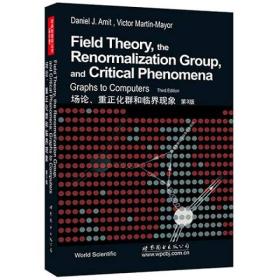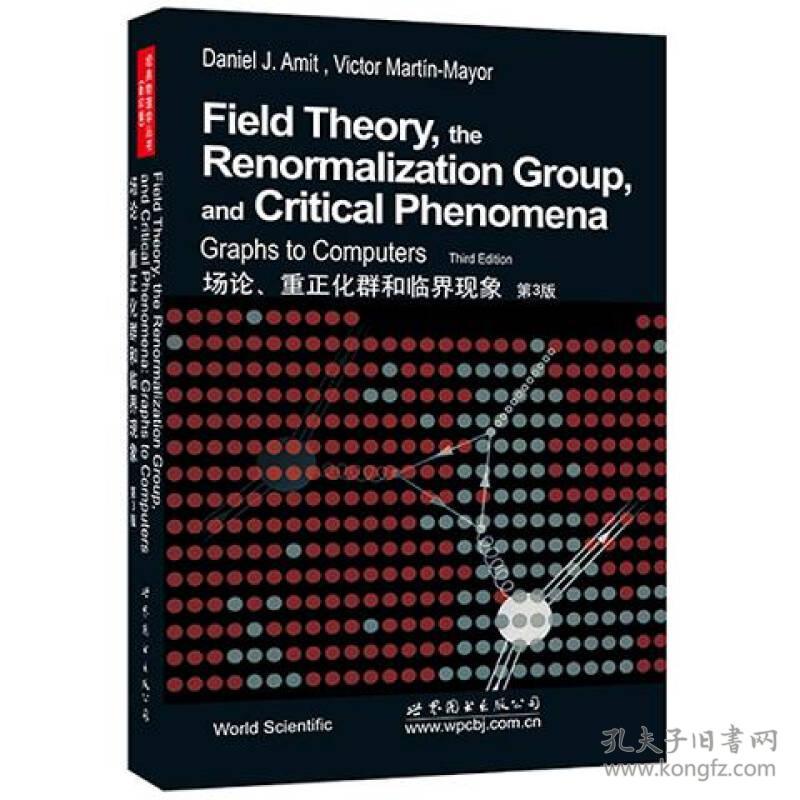
场论、重正化群和临界现象
¥ 71.37 8.0折 ¥ 89 九品
仅1件
北京海淀
认证卖家担保交易快速发货售后保障
作者[以色列]Daniel J.Amit 著
出版社世界图书出版公司
出版时间2015-04
版次1
装帧平装
货号A8
上书时间2024-12-16
- 在售商品 暂无
- 平均发货时间 14小时
- 好评率 暂无
- 最新上架
商品详情
- 品相描述:九品
图书标准信息
- 作者 [以色列]Daniel J.Amit 著
- 出版社 世界图书出版公司
- 出版时间 2015-04
- 版次 1
- ISBN 9787510087707
- 定价 89.00元
- 装帧 平装
- 开本 16开
- 纸张 胶版纸
- 原版书名 Field Theory, the Renormalization Group and Critical Phenomena: Graphs to Computers
- 【内容简介】
-
《场论、重正化群和临界现象(第3版)》被列为学习场论入门的核心教材,很少有教材能够做到如此恰到好处,详略得当,难易适中。将粒子物理学的场论方法和概念与临界现象和统计力学中的巧妙衔接起来。第一版已经被证明了是一本十分有用的教材,第二版又详细介绍了有限尺寸标度、一般性和多耦合常数的临界行为,这些都是物理学家做研究很有价值的工具。
目次:第一部分(基本观点和技巧:临界现象理论中的相关概念和观点;函数积分有关的相变问题公式;量子场论中的函数积分;顶点函数和对称性破缺;圈数和分量数的扩张;重整化;重整化群和临界区域中的标度;临界指数的计算;(第二部分)导论;主标度之外;一般性综述;多耦合临界行为;交叉现象;二维附近的临界现象;(第三部分)非扰动和数值方法:实空间方法;有限尺寸标度;蒙特卡洛方法、数值场论。附录:程序案例。
读者对象:物理专业高年级本科生、研究生和相关专业的科研人员。
- 【作者简介】
- David Yevick是国际知名学者,在数学和物理学界享有盛誉。本书凝聚了作者多年科研和教学成果,适用于科研工作者、高校教师和研究生。
- 【目录】
-
Preface
Preface to the Third Edition
General Sources and References
PARTⅠBASICIDEAS AND TECHNIQUES
1 Pertinent concepts and ideas in the theory of critical phenomena
1—1 Description of critical phenomena
1—2 Scaling and homogeneity
1—3 Comparison of various results for critical exponents
1—4 Universality—dimensionality,symmetry
Exercises
2 Formulation of the problem of phase transitions in terms of functional integrals
2—1 Introduction
2—2 Construction of the Lagrangian
2—2—1 The real scalar field
2—2—2 Complexfield
2—2—3 A hypercubic n—vector model
2—2—4 Two coupled fluctuating fields
2—3 The parameters appearing in £
2—4 The partition function,or the generating functional
2—5 Representation of the Ising model in terms of functional integrals
2—5—1 Definition of the model and its thermodynamics
2—5—2 The Gaussian transformation
2—5—3 The free part
2—5—4 Some properties of the free theory—a free Euclidean field theory in less than four dimensions
2—6 Correlation functions including composite operators
Exercises
3 Functional integrals in quanturn field theory
3—1 Introduction
3—2 Functionalintegrals for a quantum—mechanical system with one degree of freedom
3—2—1 Schwinger's transformation function
3—2—2 Matrix elements—Green functions
3—2—3 The generating functional
3—2—4 Analytic continuation in time—the Euclidean theory
3—3 Functional integrals for the scalar boson field theory
3—3—1 Introduction
3—3—2 The generating functional for Green functions
3—3—3 The generating functional as a functional integral
3—3—4 The S—matrix expressed in terms of the generating functional
Exercises
4 Perturbation theory and Feynman graphs
4—1 Introduction
4—2 Perturbation expansionin coordinate space
4—3 The cancellation of vacuum graphs
4—4 Rules for the computation ofgraphs
4—5 More general cases
4—5—1 The M—vector theory
4—5—2 Comments on fields with higher spin
4—6 Diagrammatic expansion in momentum space
4—7 Perturbation expansion of Green functions with composite operators
4—7—1 In coordinate space
4—7—2 In momentum space
4—7—3 Insertion at zero momentum
Exercises
5 Vertex functions and symmetry breaking
5—1 Introduction
5—2 Connected Green functions and their generating functional
5—3 The mass operator
5—4 The Legendre transform and vertex functions
5—5 The generating functional and the potential
5—6 Ward—Takahashi identities and Goldstone's theorem
5—7 Vertex parts for Green functions with composite operators
Exercises
6 Expansions in the number of loops and in the number of components
6—1 Introduction
6—2 The expansion in the number of loops as a power series
6—3 The tree (Landau—Ginzburg)approximation
6—4 The one—loop approximation and the Ginzburg criterion
6—5 Mass and coupling constant renormalizationin the one—loop approximation
6—6 Composite field renormalization
6—7 Renormalization of the field at the two—loop level
6—8 The O(M)—symmetric theory in the limit of large M
6—8—1 Generalremarks
6—8—2 The origin of the M—dependence of the coupling constant
6—8—3 Faithful representation of graphs and the dominant terms inΓ(4)
6—8—4 Γ(2) in theinfinite M limit
6—8—5 Renormalization
6—8—6 Broken symmetry
Appendix 6—1 The method of steepest descent and the loop expansion
Exercises
7 Renormalization
7—1 Introduction
7—2 Some considerations concerning engineering dimensions
7—3 Power counting and primitive divergences
7—4 Renormalization of a cutoff φ4 theory
7—5 Normalization conditions for massive and massless theories
7—6 Renormalization constants for a massless theory to order two loops
7—7 Renormalization away from the critical point
7—8 Counterterms
7—9 Relevant and irrelevant operators
7—10 Renormalization of a φ4 theory with an O(M) symmetry
7—11 Ward identities and renormalization
7—12 Iterative construction of counterterms
Exercises
8 The renormalization group and scaling in the critical region
8—1 Introduction
8—2 The renormalization group for the critical (massless) theory
8—3 Regularization by continuation in the number of dimensions
8—4 Massless theory below four dimensions—the emergence of ε
8—5 The solution of the renormalization group equation
8—6 Fixed points, scaling, and anomalous dimensions
8—7 The approach to the fixed point—asymptotic freedom
8—8 Renormalization group equation above Tc—identification of v
8—9 Below the critical temperature—the scaling form of the equation of state
8—10 The specific heat—renormalization group equation for an additively renormalized vertex
8—11 The Callan—Symanzik equations
8—12 Renormalization group equations for the bare theory
8—13 Renormalization group equations and scaling in the infinite M limit
Appendix 8—1 General formulas for calculating Feynman integrals
Exercises
9 The computation of the critical exponents
9—1 Introduction
9—2 The symbolic calculation of the renormalization constants and Wilson functions
9—3 The εexpansion of the critical exponents
9—4 The nature of the fixed points —universality
9—5 Scale invariance at finite cutoff
9—6 At the critical dimension —asymptotic infrared freedom
9—7 ε expansion for the Callan—Symanzik method
9—8 εexpansion of the renormalization group equations for the bare functions
9—9 Dimensional regularization and critical phenomena
9—10 Renormalization by minimal subtraction of dimensional poles
9—11 The calculation of exponents in minimal subtraction
Appendix 9—1 Calculation of some integrals with cutoff
9—2 One—Ioop integrals in dimensional regularization
9—3 Two—Ioop integrals in dimensional regularization
Exercises
……
PARTⅡ FURTHER APPLICATIONS AND DEVELOPMENTS
点击展开
点击收起
— 没有更多了 —












以下为对购买帮助不大的评价